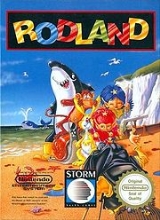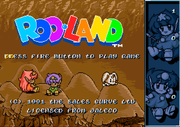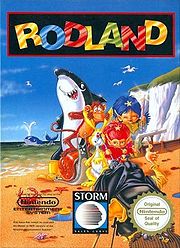
Rodland
Encyclopedia
Rod Land, known in Japan
fully titled as is a 1990 arcade game
originally developed and published by Jaleco
.
 The player(s) control one or two fairies called Tam and Rit armed with a magic wand (rod). Following the concept of Taito
The player(s) control one or two fairies called Tam and Rit armed with a magic wand (rod). Following the concept of Taito
's Bubble Bobble
, the rod doesn't kill the monsters directly, but only leaves them immobilized crying. To kill them, the rod can grasp them in a magic force-field and the player can smash them down over her head until they disappear and leave a power-up behind.
Each level is only one small screen composed of monsters, platforms, ladders and, later, tunnels. Unlike other games of the genre, the players can never jump, but have to use ladders. They can conjure one custom ladder above or below them in order to go to the appropriate platform. There can be only one such 'custom' ladder; therefore if the fairy summons it again, it will disappear from its previous position in order to appear again next to the fairy. This can be beneficial for the player, if a monster is climbing that ladder to approach her.
 The fairies' quest is to rescue their mother, trapped in a tower. In the sequel (part of the original arcade machine) they must venture into a pyramid, to stop an evil force that is building a mobile fortress. The spirit of their departed father "guides" them at a couple of points. The ending implies that the evil in the pyramid was somehow responsible for their father's death.
The fairies' quest is to rescue their mother, trapped in a tower. In the sequel (part of the original arcade machine) they must venture into a pyramid, to stop an evil force that is building a mobile fortress. The spirit of their departed father "guides" them at a couple of points. The ending implies that the evil in the pyramid was somehow responsible for their father's death.
 Originally a coin-op arcade game
Originally a coin-op arcade game
, it has since been ported to virtually every platform around in the early nineties, the first being the Amstrad CPC
version in 1990, the last being the Nintendo
Game Boy
version in 1993. (This excludes modernized remakes such as the port for Symbian mobiles in 2006.)
The home versions of the game were created by the Sales Curve Ltd from their London based development office. The Amiga and ST versions were coded by Ronald Pieket Weserick and John Crowdy, the Commodore 64 version by Steve "Snake" Palmer, and the NES version by Simon Pick. The NES version was only released in Italy, Spain and Japan. It is widely considered to be the rarest NES cartridge available.
All of these versions differ in some way — particularly the NES version, which adds some new platform stages and allows the player to jump — but by far the biggest difference is that the arcade version includes a totally different 'sequel' (with new graphics, levels, bosses and storyline) on completion of the original game. The enemies in the "second story" are more robotic. This sequel can be accessed directly at the start of the game, if the joystick is moved down three times between inserting a coin and pressing the 1P or 2P button.
In the Game Boy
version specifically, the player can strike enemies with the wand even while climbing a ladder, making the game slightly easier to play.
Rod Land was followed by a 1992 puzzle spin-off titled Soldam.
Home versions
Japan
Japan is an island nation in East Asia. Located in the Pacific Ocean, it lies to the east of the Sea of Japan, China, North Korea, South Korea and Russia, stretching from the Sea of Okhotsk in the north to the East China Sea and Taiwan in the south...
fully titled as is a 1990 arcade game
Arcade game
An arcade game is a coin-operated entertainment machine, usually installed in public businesses such as restaurants, bars, and amusement arcades. Most arcade games are video games, pinball machines, electro-mechanical games, redemption games, and merchandisers...
originally developed and published by Jaleco
Jaleco
is a Japanese video game publisher and developer established in 2006.The original Jaleco Ltd was founded in 1974. In 2006, it decided to become a pure holding company by renaming itself Jaleco Holding and splitting its video game operations into a newly created subsdiary that took its former name...
.
Gameplay

Taito Corporation
The is a Japanese publisher of video game software and arcade hardware wholly owned by publisher Square Enix. Taito has their headquarters in the Shinjuku Bunka Quint Building in Yoyogi, Shibuya, Tokyo, sharing the facility with its parent company....
's Bubble Bobble
Bubble Bobble
is an arcade game by Taito, first released in 1986 and later ported to numerous home computers and game consoles. The game, starring the twin Bubble Dragons and , is an action-platform game in which players travel through one hundred different stages, blowing and bursting bubbles, avoiding...
, the rod doesn't kill the monsters directly, but only leaves them immobilized crying. To kill them, the rod can grasp them in a magic force-field and the player can smash them down over her head until they disappear and leave a power-up behind.
Each level is only one small screen composed of monsters, platforms, ladders and, later, tunnels. Unlike other games of the genre, the players can never jump, but have to use ladders. They can conjure one custom ladder above or below them in order to go to the appropriate platform. There can be only one such 'custom' ladder; therefore if the fairy summons it again, it will disappear from its previous position in order to appear again next to the fairy. This can be beneficial for the player, if a monster is climbing that ladder to approach her.

Ports and related releases

Arcade game
An arcade game is a coin-operated entertainment machine, usually installed in public businesses such as restaurants, bars, and amusement arcades. Most arcade games are video games, pinball machines, electro-mechanical games, redemption games, and merchandisers...
, it has since been ported to virtually every platform around in the early nineties, the first being the Amstrad CPC
Amstrad CPC
The Amstrad CPC is a series of 8-bit home computers produced by Amstrad between 1984 and 1990. It was designed to compete in the mid-1980s home computer market dominated by the Commodore 64 and the Sinclair ZX Spectrum, where it successfully established itself primarily in the United Kingdom,...
version in 1990, the last being the Nintendo
Nintendo
is a multinational corporation located in Kyoto, Japan. Founded on September 23, 1889 by Fusajiro Yamauchi, it produced handmade hanafuda cards. By 1963, the company had tried several small niche businesses, such as a cab company and a love hotel....
Game Boy
Game Boy
The , is an 8-bit handheld video game device developed and manufactured by Nintendo. It was released in Japan on , in North America in , and in Europe on...
version in 1993. (This excludes modernized remakes such as the port for Symbian mobiles in 2006.)
The home versions of the game were created by the Sales Curve Ltd from their London based development office. The Amiga and ST versions were coded by Ronald Pieket Weserick and John Crowdy, the Commodore 64 version by Steve "Snake" Palmer, and the NES version by Simon Pick. The NES version was only released in Italy, Spain and Japan. It is widely considered to be the rarest NES cartridge available.
All of these versions differ in some way — particularly the NES version, which adds some new platform stages and allows the player to jump — but by far the biggest difference is that the arcade version includes a totally different 'sequel' (with new graphics, levels, bosses and storyline) on completion of the original game. The enemies in the "second story" are more robotic. This sequel can be accessed directly at the start of the game, if the joystick is moved down three times between inserting a coin and pressing the 1P or 2P button.
In the Game Boy
Game Boy
The , is an 8-bit handheld video game device developed and manufactured by Nintendo. It was released in Japan on , in North America in , and in Europe on...
version specifically, the player can strike enemies with the wand even while climbing a ladder, making the game slightly easier to play.
Rod Land was followed by a 1992 puzzle spin-off titled Soldam.
External links
Arcade version- Rod Land at arcade-history
Home versions
- Rod Land at EurocomEurocomEurocom is a British video game developer founded specifically to develop games for the Nintendo Entertainment System. Since then Eurocom has expanded to several other platforms including handheld game systems and most major video game consoles.The company was once famous for its arcade to console...

